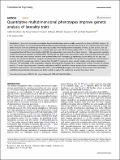Files in this item
Quantitative multidimensional phenotypes improve genetic analysis of laterality traits
Item metadata
| dc.contributor.author | Schmitz, Judith | |
| dc.contributor.author | Zheng, Mo | |
| dc.contributor.author | Lui, Kelvin F. H. | |
| dc.contributor.author | McBride, Catherine | |
| dc.contributor.author | Ho, Connie S.-H. | |
| dc.contributor.author | Paracchini, Silvia | |
| dc.date.accessioned | 2022-02-21T15:30:14Z | |
| dc.date.available | 2022-02-21T15:30:14Z | |
| dc.date.issued | 2022-02-19 | |
| dc.identifier | 277770105 | |
| dc.identifier | 10834a46-e60d-410c-b004-d6a2341eec5d | |
| dc.identifier | 000757929400002 | |
| dc.identifier | 85125005421 | |
| dc.identifier.citation | Schmitz , J , Zheng , M , Lui , K F H , McBride , C , Ho , C S-H & Paracchini , S 2022 , ' Quantitative multidimensional phenotypes improve genetic analysis of laterality traits ' , Translational Psychiatry , vol. 12 , 68 . https://doi.org/10.1038/s41398-022-01834-z | en |
| dc.identifier.issn | 2158-3188 | |
| dc.identifier.other | ORCID: /0000-0001-9934-8602/work/108915269 | |
| dc.identifier.uri | https://hdl.handle.net/10023/24918 | |
| dc.description | The UK Medical Research Council and Wellcome (Grant ref: 217065/Z/19/Z) and the University of Bristol provide core support for ALSPAC. This publication is the work of the authors and SP and JS will serve as guarantors for the analysis of the ALSPAC data presented in this paper. GWAS data were generated by Sample Logistics and Genotyping Facilities at Wellcome Sanger Institute and LabCorp (Laboratory Corporation of America) using support from 23andMe. Support to the genetic analysis was provided by the St Andrews Bioinformatics Unit funded by the Wellcome Trust [grant 105621/Z/14/Z]. The Hong Kong sample was funded through a Collaborative Research Fund from the Hong Kong Special Administrative Region Research Grants Council (CUHK8/CRF/13G, and C4054-17WF). JS is funded by the Deutsche Forschungsgemeinschaft (DFG, German Research Foundation, 418445085) and supported by the Wellcome Trust [Institutional Strategic Support fund, Grant number 204821/Z/16/Z]. SP is funded by the Royal Society (UF150663). | en |
| dc.description.abstract | Handedness is the most commonly investigated lateralised phenotype and is usually measured as a binary left/right category. Its links with psychiatric and neurodevelopmental disorders prompted studies aimed at understanding the underlying genetics, while other measures and side preferences have been less studied. We investigated the heritability of hand, as well as foot, and eye preference by assessing parental effects (n ≤ 5028 family trios) and SNP-based heritability (SNP-h2, n ≤ 5931 children) in the Avon Longitudinal Study of Parents and Children (ALSPAC). An independent twin cohort from Hong Kong (n = 358) was used to replicate results from structural equation modelling (SEM). Parental left-side preference increased the chance of an individual to be left-sided for the same trait, with stronger maternal than paternal effects for footedness. By regressing out the effects of sex, age, and ancestry, we transformed laterality categories into quantitative measures. The SNP-h2 for quantitative handedness and footedness was 0.21 and 0.23, respectively, which is higher than the SNP-h2 reported in larger genetic studies using binary handedness measures. The heritability of the quantitative measure of handedness increased (0.45) compared to a binary measure for writing hand (0.27) in the Hong Kong twins. Genomic and behavioural SEM identified a shared genetic factor contributing to handedness, footedness, and eyedness, but no independent effects on individual phenotypes. Our analysis demonstrates how quantitative multidimensional laterality phenotypes are better suited to capture the underlying genetics than binary traits. | |
| dc.format.extent | 8 | |
| dc.format.extent | 1114799 | |
| dc.language.iso | eng | |
| dc.relation.ispartof | Translational Psychiatry | en |
| dc.subject | QH426 Genetics | en |
| dc.subject | DAS | en |
| dc.subject.lcc | QH426 | en |
| dc.title | Quantitative multidimensional phenotypes improve genetic analysis of laterality traits | en |
| dc.type | Journal article | en |
| dc.contributor.sponsor | The Wellcome Trust | en |
| dc.contributor.institution | University of St Andrews. St Andrews Bioinformatics Unit | en |
| dc.contributor.institution | University of St Andrews. Centre for Biophotonics | en |
| dc.contributor.institution | University of St Andrews. Cellular Medicine Division | en |
| dc.contributor.institution | University of St Andrews. Biomedical Sciences Research Complex | en |
| dc.contributor.institution | University of St Andrews. School of Medicine | en |
| dc.identifier.doi | 10.1038/s41398-022-01834-z | |
| dc.description.status | Peer reviewed | en |
| dc.identifier.grantnumber | 105621/Z/14/Z | en |
This item appears in the following Collection(s)
Items in the St Andrews Research Repository are protected by copyright, with all rights reserved, unless otherwise indicated.

